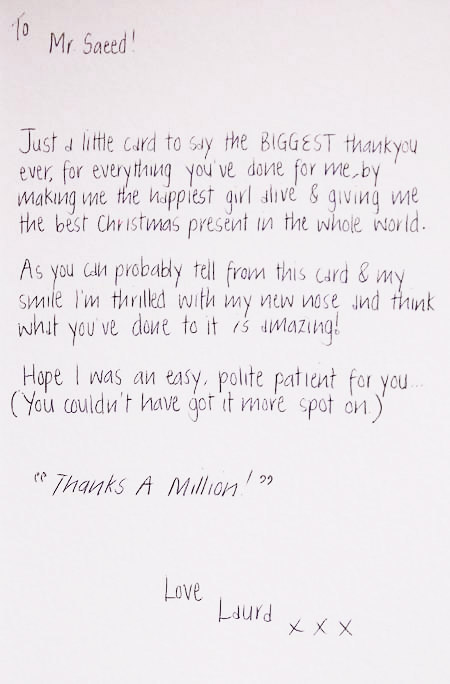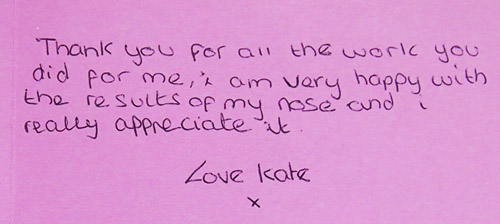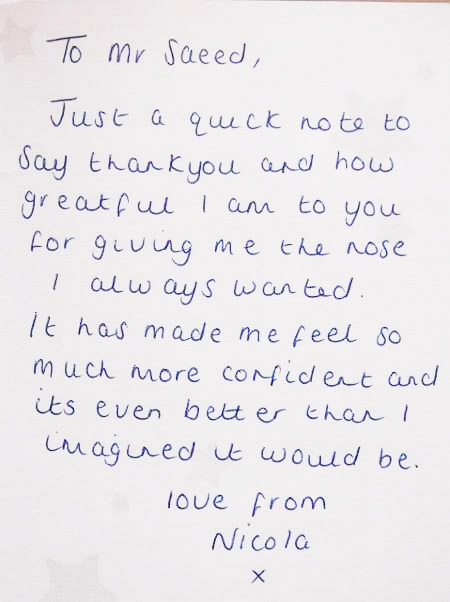This page covers a specialist area of mine and should be read in conjunction with my page on standard rhinoplasty. Revision rhinoplasty is an operation to correct problems following a previous rhinoplasty. It includes the terms secondary (2nd operation), tertiary (3rd operation) and quaternary (4th operation) rhinoplasties.
Of all aesthetic procedures rhinoplasty carries one of the highest rates of revision. This is because there is an inherent unpredictability in the way tissues will settle after nasal surgery and a huge variation in every aspect of the nose – each of us has our own unique nose. Added to this are the standard complications that can occur with any surgery and recovery process. Just because you are considering / have been offered further (revision) surgery, it does not mean that your original surgery was substandard or botched – sometimes things just do not go as planned no matter how carefully the original surgery was carried out.
There are a number of reasons that patients undergo this procedure, both aesthetic (appearance) and functional and I have listed some of these that I see with varying frequency. You should note that just because these problems might be present, it does not mean that you need further surgery – milder forms of any of these are compatible with an attractive appearance and are common in the general population. You should also note that the functional problems might have other causes separate from the nose
- The nose lacks definition
- The nasal tip is bulky or shapeless, significantly asymmetric or has dropped
- In females – the nose is not feminine, in males too feminine
- The nose is deviated (bent)
- There is a persisting bump in the nose (dorsal hump)
- There is excess scar tissue, soft tissue bulk or cartilage in the area above the tip spoiling nasal shape
(supratip excess) - The tip drops when smiling
- The nostrils are too peaked / arched
- The nose is too long / short for the face
- The nose projects forward too little or too much for the face
- The nasal tip is too high / reveals too much of the nostrils (‘piggy nose’)
- Irregularities of the nasal bridge or tip.
- Breathing is difficult through one or both nostrils
- Recurrent persistent nasal drainage / bad smell in the nose
- Tethering of skin or scars with distortion of the nose
Revision rhinoplasty covers a wide range of procedures from minor adjustments to complex reconstructive work and may require work on the nose alone or combined with work on the nasal septum (septoplasty)
At consultation I carry out a thorough assessment which includes your original aims, details of pre-existing nasal issues, details of previous operations and your current concerns and aims. Alongside this is your general medical history to ensure that you are safe for surgery.
Form these and a subsequent second (at least) consultation it is usually possible to discern whether further surgery is possible and if it is likely to improve the nose. If surgery is an option, the pros and cons of further surgery versus accepting your nose are discussed
and a working surgical plan devised if this is appropriate. It is always advisable to take time to think about this decision and this is something that I also do as your surgeon.
The surgery itself is specialist and involves familiarity with a variety of techniques. In any given operation I may need to carry out any of the following:
- Re-stablishing nasal foundations and support- nasal bone re-positioning, septum repositioning, septal stabilisation with spreader or extension grafts (septoplasty).
- Bridge refinement, lowering, raising, reconstruction
- Tip, reconstruction, repositioning, adjusting shape, refining with grafts
- Airway internal and external valve stabilising with grafts
- Scar tissue releasing, removing and skin re-draping













